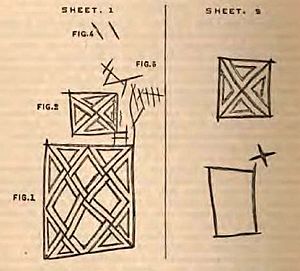Knockmore facts for kids
Knockmore is a special place in County Fermanagh, Northern Ireland. It's an upland area, which means it's a hilly region, and it's also a townland (a small area of land). Knockmore is found near the village of Derrygonnelly. Its name comes from the Irish words "Cnoc Mór," which mean "big hill."
The highest point in Knockmore is its summit, standing tall at 277 meters (about 909 feet). This area, along with nearby parts of Boho, is known as the Knockmore Scarplands. It's a very important natural place because of its unique plants, animals, and rocks. Because of this, it's protected as an Area of Special Scientific Interest (ASSI) and a Special Area of Conservation (SAC). Scientists and historians have also found many interesting old sites here.
Contents
Amazing Geology of Knockmore
Knockmore is famous for its impressive cliffs. These cliffs are made of a special kind of rock called Knockmore Limestone. This type of limestone is known for having many caves hidden inside it. The way the rocks are formed here tells us a lot about the Earth's history.
Unique Plants and Animals
The plants and animals living in Knockmore are very special. They thrive here because of the limestone and sandstone rocks found in the ground. You'll find a mix of upland heath, which is like a wild, open land with small shrubs, and calcareous grassland, which is grassy land rich in lime.
One plant that makes Knockmore stand out is the Irish eyebright (Euphrasia salisburgensis). This tiny plant is considered very important in Northern Ireland, and Knockmore is one of the best places to find it.
A Glimpse into Knockmore's Past
Knockmore has a long history, with stories passed down through generations. Old tales mention that a castle belonging to the Flannagan Clan once stood on Knockmore. Imagine a castle on top of this big hill!
Exploring Ancient Caves
The summit of Knockmore is home to at least 15 small caves. People have been exploring these caves and studying them since the late 1800s.
The most famous cave is called "Lettered Cave" or "Inscribed Cave." It's only about 50 meters from the very top of Knockmore. Parts of this cave were even shaped by humans a long, long time ago.
The cave gets its name from the many drawings and writings on its walls. These range from very old Celtic and early Christian designs to simple names and dates left by visitors over the centuries. Important explorers like William Wakeman and Thomas Plunkett studied this cave in the late 1800s. Today, it's a protected ancient monument, meaning it's kept safe for future generations to learn from.
Another interesting cave on Knockmore is Gillie's Hole. It's located partway down the southern cliff face. This cave is named after a young couple who reportedly lived there in the 1700s after being separated from their families. When William Wakeman explored Gillie's Hole in 1870, he also found ancient Celtic writings inside, just like in Lettered Cave. These caves are like secret libraries, holding clues about the people who lived here long ago.


